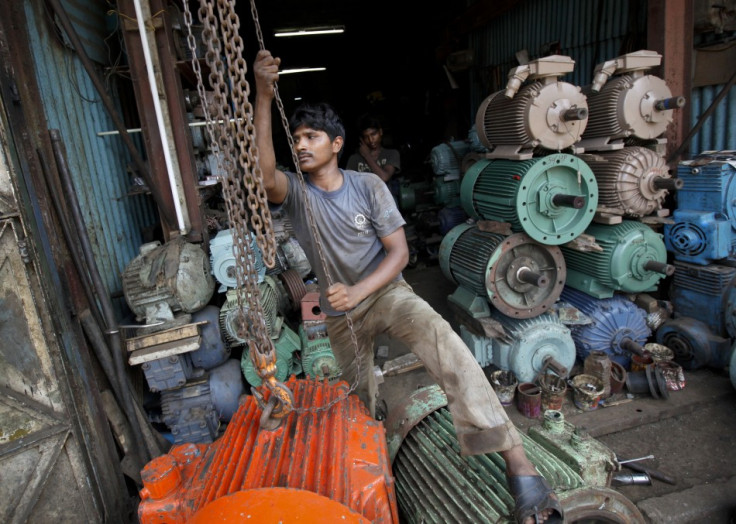India BRICing it? Former Emerging Market Star Sees Growth Slump to Near Decade Low
The former star-pupil of the BRIC class of emerging market economies looks to have slumped to the bottom of the registers after a first quarter GDP report card that's showing the slowest pace of growth in nearly a decade.
Following a decline in manufacturing output, which shrank 0.3 percent from the year earlier, the overall 5.3 precent GDP advance is spectacularly lower than the consensus forecast of 6.1 percent.
Furthermore, India's economy only grew 6.5 percent in the last fiscal year ending March 31 2012, which is lower than the government's projection of a 6.9 percent expansion.

Meanwhile, India's fiscal deficit during the 2011/12 fiscal year was 5.2tn rupees, which is equivalent to 5.9 percent of India's GDP, according to a Reuters calculation
The latest data may come as a shock to some, but to IBTimes UK, we have been highlighting the fundamental issue that surrounds India and that is the gulf between analysts and government forecasts and actual data.
Constant over-estimation
Indian economy growth rates, much like most of the BRIC (Brazil, Russia, India and China) countries, are attractive, compared with waning growth or double dip recessions scattered around Europe.
Before the credit crisis, India was growing at a rate of 9 percent and was tipped to be a worthy challenger to China as the leading emerging market economy.
However, while times have changed and resources have become strained, there is a key issue that seems to be continually skimmed over.
At IBTimes UK, we have highlighted the worrying trend of both high government estimates for GDP and overly bullish analyst forecasts for Indian GDP.
Only last month, Standard & Poor's (S&P) slashed India's sovereign credit outlook from stable to negative and while this was a surprise for some, it really should not be a surprise to anyone.
Over the last year, the Indian government has had to revise its economic growth forecast several times, as it still gripped tightly on the idea that the country was able to deliver the 9 percent growth from previous years.
Back in mid-December 2011, the Indian government was forced to officially scale back its economic growth forecast it made in February that year, from the inflated view of 9 percent, after Indian GDP actually only expanded 6.9 percent in the third quarter 2011.
When it finally revised its growth predictions, it still stood at 7.25 percent - 7.5 percent, which is still significantly above recent data, which shows India's economic expansion moderating to 6.1 percent in the quarter ending December 31.
Various banks have had to do the same, which we reported at theIBTimes UK in April.
However, despite this history of events and not learning from previous mistakes, consensus for the latest quarter stood at 6.1 percent. Not surprisingly, actual data was much lower. As IBTimes UK reported last month, it would seem that banks do have a vested interest in keeping projections on the more bullish side, after many have ploughed investment into operations in emerging markets.
Moreover, behind the numbers, there are several major factors that causing a headache for India.
Domestic issues
The dismal Indian economic data weighed heavily on India's stock, currency and bond yields today. India's Sensex fell by over 1 percent, the Indian rupee tumbled and bond yields declined, in response to GDP figures.
While the negative market reaction comes with the territory, there are fundamental issues that India is facing.
"Evidence abounds in plenty that economic reforms and monetary easing need to be stepped up and urgently," says Sanjay Mathur, emerging markets analyst at RBS. "The slowdown in growth that started four quarters ago has only intensified with the Q4 FY12 (fiscal year ending March 2012) coming in lower than the weakest of street estimates. It is remarkable to see that the debate over Indian growth has shifted from 9 percent-10 percent to 6 percent-7 percent."
Foreign investors have become weary of the governmental backtracking and delay over economic reform and tax. The government's actions on these issues have contributed to its negative outlook and will threaten its overall credit rating.
Furthermore, the third largest economy in Asia, India is still suffering from inflation and currency weakness.
The Indian rupee has plummeted by more than 27 percent against the US dollar since July 2011. Coupling inflation and a currency, spending power is waning and anger towards with Prime Minister Manmohan Singh's embattled coalition government has intensified.
"The message from the numbers is clear - economic reforms need to be revived and monetary easing has to become more aggressive," says Mathur. "And on an urgent basis. Corporate profits are simply too weak for investment to recover without a policy impetus. Similarly, the cost of capital as measured by a blended average of the interest on AAA 10y local currency corporate bonds and the earnings yield remains elevated."
Singh's coalition government has already been weakened by infighting, which has prevented the passing of much needed economic reforms and a string of corruption scandals.
In relation, India is set encounter a wave of protests over the steepest petrol price rise in the country's history.
The Indian public, who are already feeling the squeeze from weakening domestic demand and tumbling purchase power, are said to strike and set up blockades from state to state in response to the petrol price changes. The strikes only highlight the need for swifter and concise economic reforms.
"Whether economic reforms will be revived or not is known only to the mandarins in New Delhi," says Mathur. "The list is long ranging from formulation of appropriate policies in mining, land acquisition to improving governance. However, monetary policy can be eased and this is an issue that is bound to be debated aggressively in the coming days."
© Copyright IBTimes 2024. All rights reserved.






